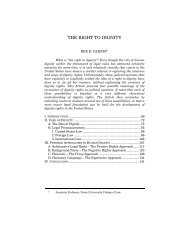A Right to Media? Lorie M. Graham - Columbia Law School
A Right to Media? Lorie M. Graham - Columbia Law School
A Right to Media? Lorie M. Graham - Columbia Law School
Create successful ePaper yourself
Turn your PDF publications into a flip-book with our unique Google optimized e-Paper software.
2010] A RIGHT TO MEDIA? 461<br />
This can be further illustrated by considering General<br />
Recommendation 21 of the Committee on the Elimination of Racial<br />
Discrimination (CERD) on the right <strong>to</strong> self-determination, which<br />
states in part that governments should be aware of the rights of<br />
persons belonging <strong>to</strong> ethnic, religious, and linguistic groups,<br />
particularly their rights <strong>to</strong> lead lives of dignity, <strong>to</strong> preserve their<br />
culture and identity, <strong>to</strong> share equitably in the fruits of national<br />
growth, and <strong>to</strong> participate “in the government of the country of which<br />
they are members.” 123 Since robust, accessible media is capable of<br />
nurturing culture and identity, and facilitating involvement in the<br />
development issues of a country, supporting indigenous forms of and<br />
access <strong>to</strong> media is one way that states can satisfy their obligation <strong>to</strong><br />
respect the rights of indigenous peoples.<br />
There are many other examples of linkages between media<br />
and the self-determining rights of indigenous peoples. One primary<br />
area of concern is land and resources. Indigenous peoples’ connection<br />
<strong>to</strong> and control of ancestral lands and resources is an aspect of selfdetermination<br />
impacted by media rights. These rights intersect with<br />
two other well established norms, prior informed consent and<br />
consultation. The right of prior and informed consent is particularly<br />
important for indigenous peoples given their his<strong>to</strong>ry of being<br />
deprived of their “lands, terri<strong>to</strong>ries, and resources” without “their<br />
free and informed consent.” 124 According <strong>to</strong> CERD, “no decisions<br />
directly relating <strong>to</strong> [indigenous peoples’] rights and interests . . .<br />
[should be] taken without their informed consent.” 125 In furtherance<br />
of this aim, CERD recently recommended <strong>to</strong> the United States that it<br />
consult and cooperate in good faith with the indigenous peoples<br />
concerned before adopting and implementing any activity in areas of<br />
spiritual and cultural significance <strong>to</strong> Native Americans. 126<br />
More broadly, the 1992 Rio Declaration on Environment and<br />
Development’s Principle 10 speaks <strong>to</strong> the well recognized standard of<br />
prior informed consent, acknowledging that the resolution of<br />
123. Comm. on the Elimination of Racial Discrimination, Report of the<br />
Committee on the Elimination of Racial Discrimination, annex VIII, para. 10,<br />
U.N. Doc. A/51/18 (Sept. 30, 1996).<br />
124. Comm. on the Elimination of Racial Discrimination, General<br />
Recommendation on the <strong>Right</strong>s of Indigenous People, annex V, para. 5, U.N. Doc.<br />
A/52/18 (Aug. 26, 1997).<br />
125. Id. at dec. 2(54), para. 9.<br />
126. Comm. on the Elimination of Racial Discrimination, Concluding<br />
Observations of the Committee on the Elimination of Racial Discrimination, para.<br />
29, U.N. Doc. CERD/C/USA/CO/6 (Mar. 5, 2008).















